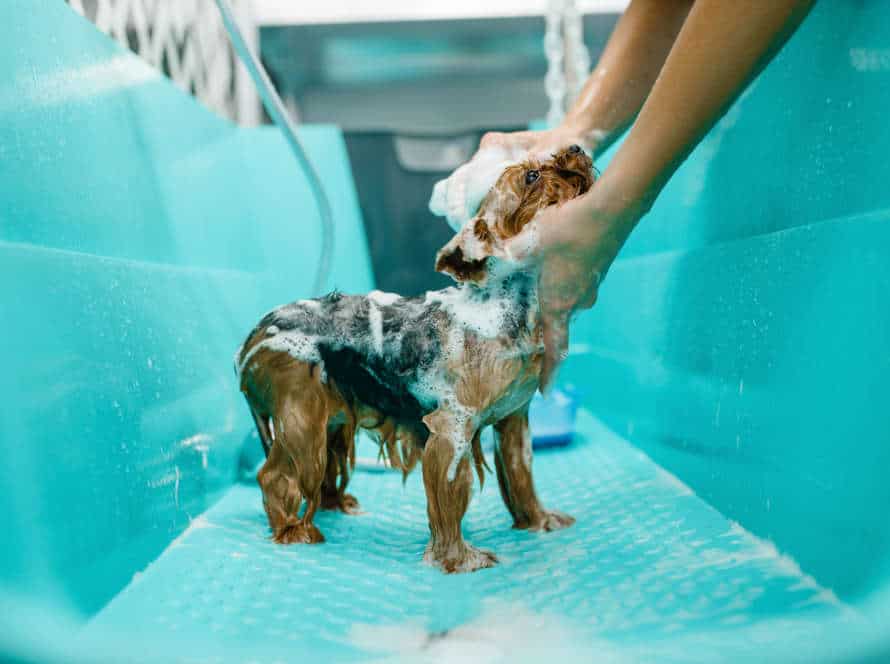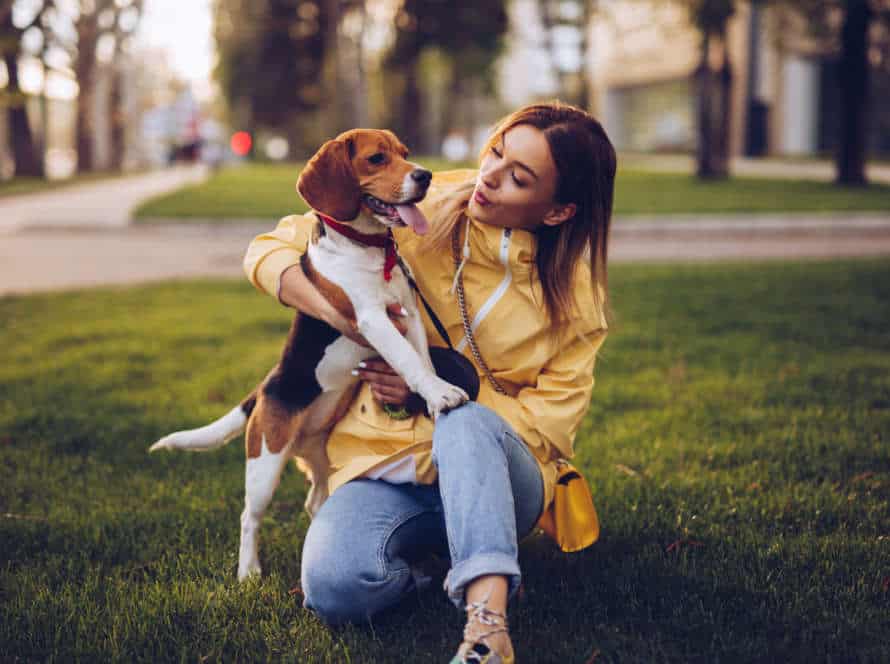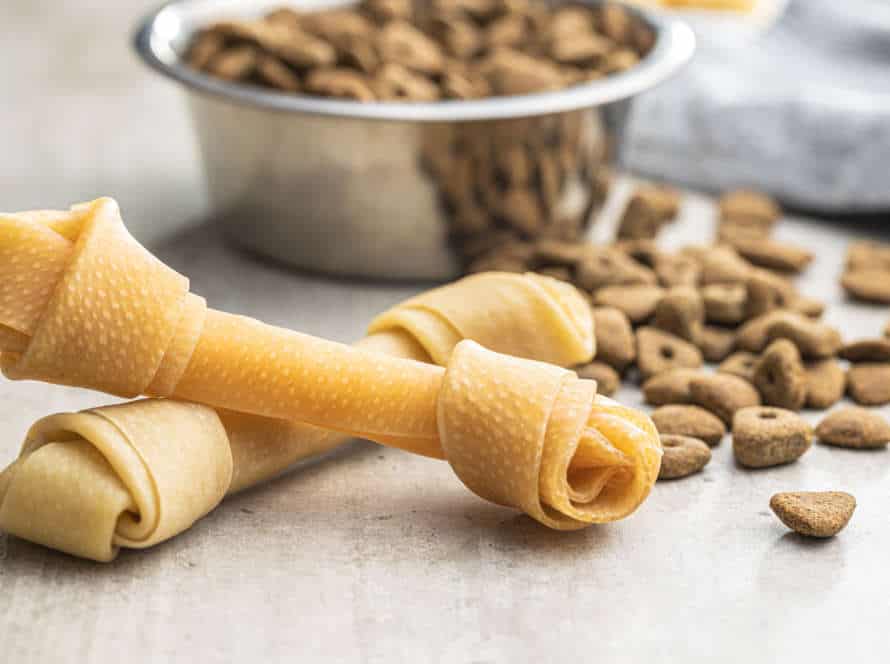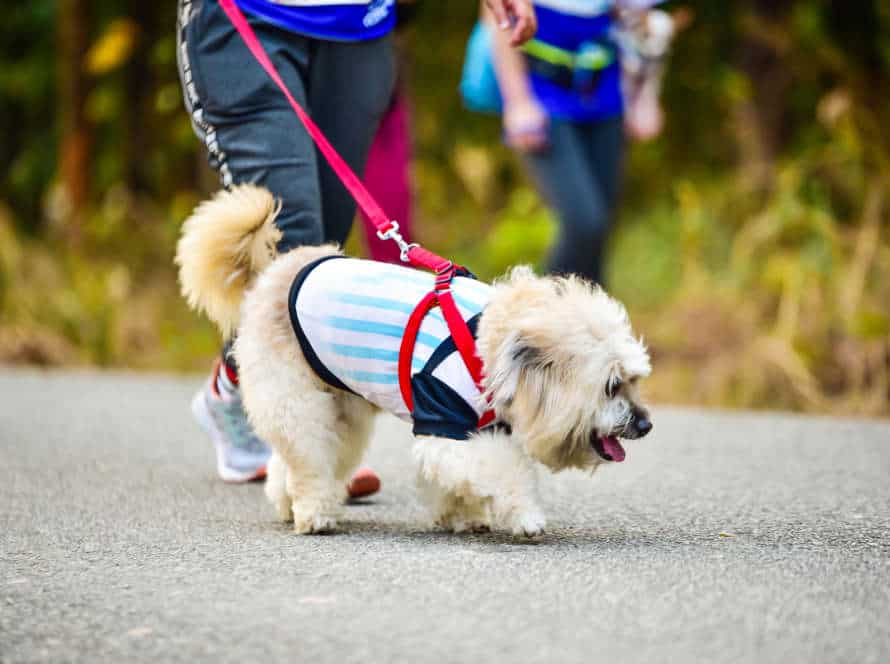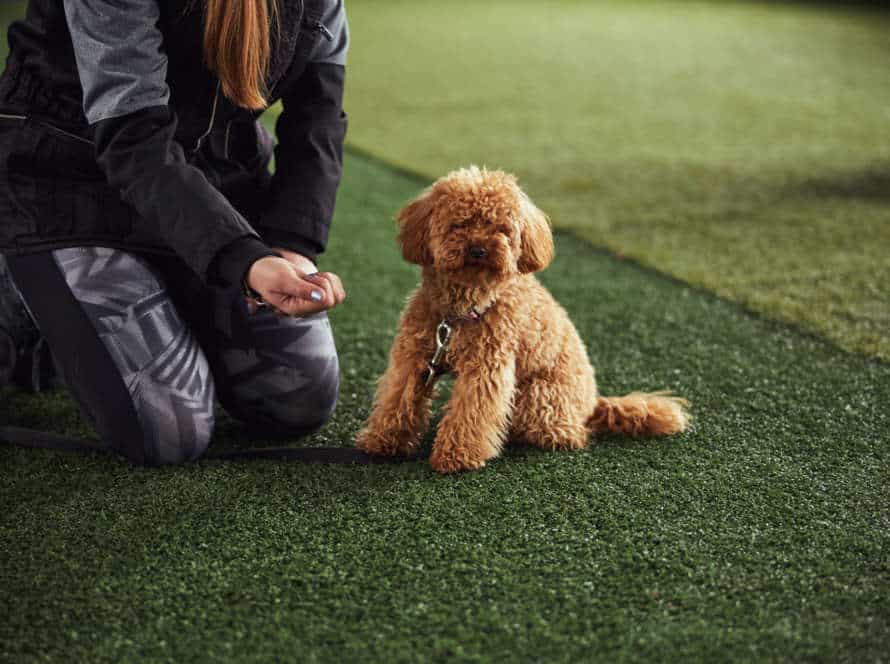Understanding Senior Dog Grooming
Your furry friend has entered the senior stage of life. So, their grooming routine needs to be changed accordingly. Bathing and brushing are still necessary, though the approach should be different from when they were young. To help you care for an aging pet, let’s explore senior dog grooming further.
Recognizing the unique grooming needs of senior dogs
As dogs age, their grooming needs differ. It’s important to recognize these changes and adjust to them for the pup’s health and joy. Here are some senior dog grooming tips:
- Brushing: Senior dogs may have more delicate skin, so use a brush with soft bristles and be mindful not to pull or tug.
- Bathing: Older dogs may have joint pain or arthritis, so use a non-slip surface in the tub and a mild shampoo to prevent skin irritation.
- Nail Trimming: Senior dogs may have weaker, more fragile nails. So take extra care when cutting to avoid injury or bleeding.
- Dental Care: Older dogs are more likely to have dental issues so regular brushing and professional cleanings are necessary.
Overall, a consistent grooming routine is needed to help keep elderly pups healthy and content in their golden years.
Understanding the physical limitations of senior dogs during grooming
As dogs age, physical changes occur. These must be taken into account when grooming senior dogs. It’s essential to understand their physical limitations for their safety, comfort and well-being.
Joint pain, arthritis and decreased mobility are some physical issues senior dogs may experience. Adjust your grooming tools and techniques to cater to your pet’s needs. Here are some tips:
- Be gentle and patient. Avoid tugging or pulling on matted or tangled fur.
- Use a tool suited to the coat type and length, such as a slicker brush, undercoat rake, or shedding blade.
- Divide grooming sessions into shorter, more frequent ones.
- Use a non-slip mat or towel for traction during bathing and grooming.
- Monitor your pet’s breathing, heart rate, and body temperature.
- Pro Tip: Consider hiring a professional groomer who specializes in senior dog grooming or mobile grooming services. They can cater to your pet’s needs in the comfort of their own home.
How senior dog grooming differs from grooming of younger dogs
As pups age, their grooming requires special attention to their health and age problems. Here are a few differences between senior dog grooming and younger dogs:
- Coat care: Fur may be thin, dry, or matted, needing extra conditioning and combing.
- Nails trimming: Less active, natural wear of nails is reduced, needing regular trimming.
- Bathing: Mobility issues or sensory loss may require raised tubs, non-slip mats, or shampoo products for dry skin.
- Eyes and Ears: Extra cleaning and attention is needed to keep them free of debris and avoid infections.
Pro-tip: Grooming often can help detect age-related issues early and maintain the senior pup’s health and well-being.
Essential Senior Dog Grooming Practices
Grooming your elderly pup is a must for their wellness. Adhering to a schedule can aid maintain your pet’s fur, skin, and nails. This can positively impact their overall health. Here, we’ll talk about the essential senior dog grooming habits that you should be aware of.
Brushing and combing senior dogs regularly
As dogs age, their grooming needs shift. Regularly brushing and combing senior dogs is essential for their coat health and comfort. Here are the benefits:
- Removing tangles and mats that may irritate skin.
- Reducing shedding and keeping fur soft and glossy.
- Boosting healthy circulation and skin health.
- Checking for lumps, bumps, or skin issues.
When grooming your senior dog use a soft-bristled brush and detangling comb. Begin at their head, being gentle around sensitive areas like ears, belly, and paws.
Pro tip: Reward your senior dog with treats and praise throughout grooming to keep them relaxed and comfortable.
Bathing senior dogs and choosing the best dog shampoos
For senior doggos, special care and attention is needed for bathing and grooming. As a pet parent, it’s essential to keep a routine that’s best for your pup. Here are some tips:
- Get a shampoo specially made for senior dogs to keep their skin healthy and pH balanced. Don’t use human shampoos as they can be too harsh.
- Use warm water for their bath. Hot water isn’t comfy for them.
- Be gentle when you bathe and massage their skin. No pain or discomfort.
- Use a towel or hairdryer to fully dry their coat. Make sure they’re all dry before you let them out – otherwise they’ll catch a cold!
- Senior doggos may need to be bathed less often. Talk to your vet to figure out what’s right for your pup.
Trimming senior dog’s nails
Trimming your senior dog’s nails is key to their health. As they age, their nails become fragile, making them more likely to break or crack. This can be painful and cause infections. Here are some tips to help:
- Use nail clippers made for dogs – they should be sharp and sturdy.
- Cut off a small amount of the nail at a time.
- Avoid the quick – it’s the pink part of the nail with blood vessels and nerves.
- If their nails are dark and the quick is hard to find, be extra careful.
- You can use a nail file to make the edges smooth.
- Give your pup treats or praise throughout the trimming to keep them calm.
Regular nail trims will make your senior dog more comfortable and help prevent any issues.
Special Grooming Needs of Senior Dogs
Your pup grows older, and their grooming needs might alter. It’s important to adjust their grooming routine! Senior dogs may need more brushing and baths, plus dental care. Things like nail trimming and ear cleaning can keep them happy and healthy. Let’s learn more about the special grooming needs of senior dogs.
Cleaning your senior dog’s ears
Keep your senior pup’s ears clean: it’s a must-do! Here are the steps:
- Get cotton balls, ear cleaning solution, and treats.
- Have your pup sit or lie down.
- Put a few drops of cleaning solution in the ear canal. Massage the base for 30 secs.
- Use a cotton ball to remove the solution and wax.
- Reward with treats and praise.
- Clean your pup’s ears once a week. Pro tip: Check with your vet before using any solution, and look for signs of infection or injury.
Teeth brushing and gum care for your senior dog
As pups age, their oral health needs become more essential for keeping them in good shape. Brushing teeth and taking care of gums properly can avoid dental issues and make sure your senior pooch stays healthy.
Here’re some tips to aid you look after your older pup’s oral health:
- Use a toothbrush and toothpaste specifically made for dogs to brush their teeth softly. Concentrate on the back teeth and gum line.
- Give your dog dental chews or bones produced to remove tartar and plaque.
- Schedule regular vet visits to check your senior pup’s oral health and take care of any dental issues quickly.
- Keep up a normal grooming schedule that includes brushing their coat, cutting their nails, and cleaning their ears. This’ll keep them healthy and contented in their golden years.
Grooming a senior dog with skin allergies
Grooming a senior pup with skin allergies needs special care. Here’s how to do it right:
- Choose hypoallergenic shampoo and conditioner. Ask your vet for product tips.
- Use a brush with soft bristles to remove loose hair and stop matting.
- Look closely at the parts near the collar. They can get infected or irritated.
- Keep the ears clean and dry to stop ear infections.
- Trim the nails often. Don’t let them grow too long.
- Do regular grooming to keep your senior pup healthy and happy.
Senior Dog Grooming Supplies
Your pet’s aging? Special care is a must! Get them a set of grooming supplies. It’ll make things easier and keep your senior pet comfortable. Here, we’ll tell you what you need for senior dog grooming.
Essential grooming tools: combs, brushes, and scissors
Grooming is key to your senior pup’s wellbeing. It’s important to have the right tools. Here are three must-haves:
- Combs: A comb helps remove knots, mats, and dirt. Widely spaced teeth for thick coats, narrow for shorter fur.
- Brushes: Brushes remove loose hair, dirt, and oil from the coat. Bristle brush for short-haired dogs, slicker brush for long-haired breeds with an undercoat.
- Scissors: Essential for trimming and styling fur. Sharp, curved scissors for precision, blunt-tipped for safety, thinning shears for thick coats.
Routine grooming with brushing and trimming can help spot health issues early and keep your senior pup’s coat healthy.
Pro tip: If your senior pup has mobility issues, use a raised table or grooming harness to make it more comfortable.
Non-toxic, scent-free grooming products
As your pet grows older, it’s important to use grooming products that are non-toxic and free from scents. Here are some essential senior dog grooming products you should have:
- Pet Wipes: Pet wipes are gentle and pH balanced, perfect for cleaning dirt and germs from paws, face, and other sensitive areas.
- Mild Shampoos: Choose shampoos free from artificial fragrances and chemicals. Look for shampoos with natural ingredients such as oatmeal, aloe vera, and coconut oil.
- Conditioners: Conditioners keep your dog’s coat soft and healthy. Avoid irritation or inflammation by choosing a conditioner that’s free from harsh chemicals.
- Brush: Brushing your senior dog’s coat detangles it and keeps it clean. It also stimulates blood circulation, promoting a healthy coat. Use brushes with soft bristles to avoid any pain.
Non-toxic and scent-free grooming products designed for your aging pet’s sensitive skin will help them feel comfortable. Avoid unwanted skin reactions!
Mobility aids for senior dogs during grooming
When it comes to grooming senior pups, mobility aids can make it simpler and less nerve-wracking for your furry pal. Here are some to consider:
- Ramps and stairs – If your elderly doggo has difficulty getting in and out of the tub or onto the grooming table, then a ramp or set of stairs can help them pass these barriers without much effort.
- Harnesses and slings – These tools can provide steadiness and aid for dogs with mobility problems. They may also help you lift your senior pup onto the grooming table or into the tub.
- Non-slip mats – Senior doggos may struggle to keep their footing on slippery surfaces, such as the floor in your grooming area. Placing a non-slip mat beneath their paws can give extra grip.
- Grooming table with adjustable height – Investing in a grooming table that you can adjust to your senior pup’s height can make it easier to groom them without straining their joints. This may also assist elderly doggos with mobility troubles feel more secure during grooming.
With the right mobility aids, you can guarantee that your senior pup stays comfortable and safe during grooming sessions.
Tips for At-home Senior Dog Grooming
Your pup’s senior years? Grooming is a must! Coat, nails, eyes and ears – they need loving care.
Senior dog grooming? No problem! It’s simple and can be done at home. Tips? Here ya go: At-home senior dog grooming – easy-peasy!
Establishing a routine for senior dog grooming
It’s key to set up a routine for elder dog grooming. Here’s how to groom your canine companion at home:
- Brush their coat often to remove fur and stop tangles. Use a brush with soft bristles to avoid skin irritation.
- Inspect their ears for infection or wax build-up. Clean them with a vet-recommended product.
- Trim their nails to prevent them from growing too long and causing pain or harm.
- Brush their teeth to stop dental issues and bad breath.
- Bathe them every now and then to keep their coat clean and glossy. Use a mild shampoo made especially for senior dogs.
By sticking to a routine, you can help your aging pup stay healthy and clean – plus, you get quality time with them!
Proper handling techniques for senior dogs
As your furry companion ages, caring for them needs more attention. Good handling methods are necessary for senior pooches, particularly during grooming. Here are some tips to make At-home Senior Dog Grooming successful:
- Prepare the grooming area before. Make sure all you need is close.
- Always keep a peaceful atmosphere while grooming your elderly dog.
- Gently brush and comb. Show your pup patience and kindness when tackling knots or tangles.
- Prevent using scissors or clippers near sensitive areas, like the face, ears, and paws. Use rounded-tip scissors, if needed.
- Routine grooming is essential for your senior pooch’s wellbeing. Stick to a consistent grooming routine to prevent strain and over-excitement.
- Good grooming methods can improve your senior dog’s agility, flexibility, and general cheerfulness. With patience, love, and attention, you can help your furry buddy enjoy their golden years.
Tips for calming anxious senior dogs during grooming
Grooming can be a struggle for senior dogs. Here are some helpful tips to ease your pup’s stress during their grooming session:
- Find a spot where your pooch feels safe and relaxed.
- Use tools that are gentle on their skin and fur.
- Stick to a regular grooming routine.
- Provide treats and kind words to show your appreciation.
- Take breaks if your senior pup gets overwhelmed. Monitor their behavior throughout the process.
These tips can help make grooming a positive experience for your senior dog. That way they will be comfortable and their grooming needs will be taken care of.
Frequently Asked Questions
1. How often should I groom my senior dog?
It’s important to groom your senior dog regularly, but the frequency will depend on their coat type and physical condition. Dogs with long hair or thick coats may need grooming every 4-6 weeks, while dogs with short hair may only need grooming every 6-8 weeks. Additionally, dogs with mobility issues or health conditions may need more frequent grooming to prevent matting and skin irritations.
2. What should I look for when selecting grooming products for my senior dog?
When selecting grooming products for your senior dog, look for products that are specifically designed for dogs with sensitive skin or allergies. Avoid products that contain harsh chemicals, which can be irritating to your dog’s skin. Use a mild shampoo and conditioner that will help to nourish your senior dog’s coat and prevent dry or itchy skin.
3. What are some signs that my senior dog may need professional grooming?
If your senior dog has a long or thick coat, they may need professional grooming to prevent matting and skin irritations. Additionally, if your senior dog has mobility issues, they may have difficulty grooming themselves and may require the help of a professional groomer. Signs that your senior dog may need professional grooming include a dull or dirty coat, excessive shedding, or mats or tangles in their hair.
4. How can I make grooming a positive experience for my senior dog?
To make grooming a positive experience for your senior dog, start by introducing them to grooming tools and products at a young age. Use positive reinforcement techniques, such as treats and praise, to help your senior dog associate grooming with a positive experience. Additionally, take breaks as needed and be patient with your senior dog, as they may need more time to rest during grooming sessions than they did when they were younger.
5. What are some tips for grooming my senior dog’s nails?
To groom your senior dog’s nails, start by getting them used to having their paws handled. Gently touch their paws and reward them with treats and praise. Use a quality pair of dog nail clippers to trim your senior dog’s nails, being sure to avoid the quick (the pink part of the nail that contains blood vessels). If you’re unsure about how to trim your senior dog’s nails, consult with a professional groomer or veterinarian.
6. What do I do if my senior dog’s skin is irritated after grooming?
If your senior dog’s skin is irritated after grooming, it may be due to an allergic reaction to the grooming products you used. Check the ingredients label on your grooming products to see if there are any known irritants, and switch to a hypoallergenic brand if necessary. If the irritation persists, consult with your veterinarian.


